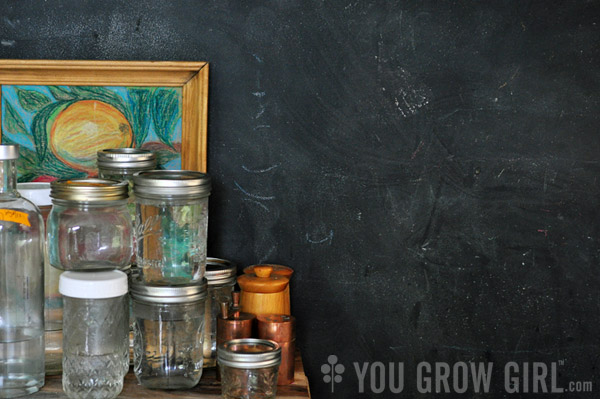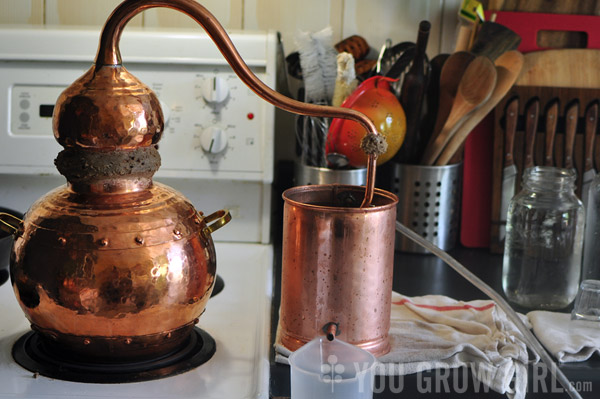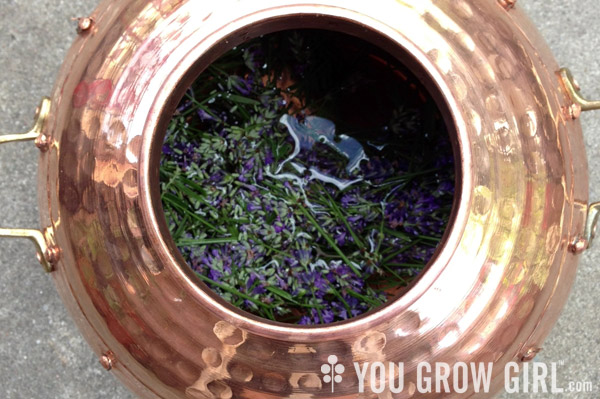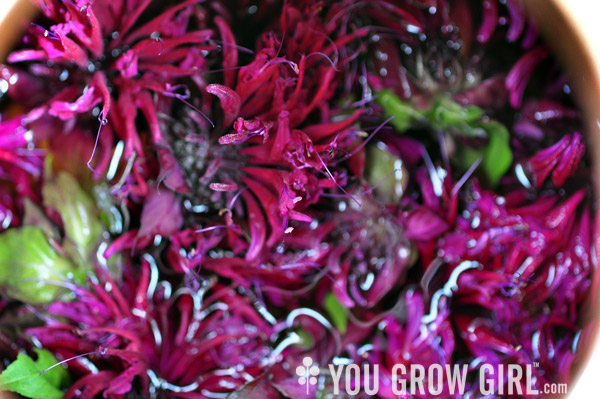
Oh, how I love my alembic copper still! I’ve been having such a great time experimenting with it over these past few weeks. The process of distilling plant matter in water to make hydrosol is creative and right brained, but it also engages my left brain in just the right way. It feels like alchemy, cooking, science, and sculpture rolled into one.

The still in use to make plant hydrosol. Here you can see the rye paste that is applied to seal up the seams.
I began the process by prepping my still. The rivets inside were sealed with a food-safe greenish paste that is comprised of linseed oil. The smell inside when I first peered in was intense and I was advised in the supporting literature that came with the still to do a cleaning run with water only. Unfortunately, I did not find that one run with water was enough to eliminate the smell, so I decided to try another cleaning using a slurry of water and rye flour. I read that the rye slurry can help seal up any possible leaks around the rivets. However, I did not notice any leaks in the first water run and to be honest, I’ve washed the bottom portion of the still so many times since that I can’t imagine how long a seal like that could last. I have found along the way that a thorough cleaning (with hot water and no scrubbing) is essential after every run as the remaining essential oils can strongly influence the scent of the next hydrosol made. The rye run made a huge difference in reducing the linseed smell and the still was noticeably less stinky after this run. One important lesson I learned during that run was how important it is to watch the temperature closely. The rye was more volatile and the lid blew off shooting an oatmeal-like mixture all over the kitchen!

Prepping my first run with lavender. Since them I have significantly reduced the amount of stems and leaves used. These parts have a different smell and I found that the outcome had a stronger “green” quality to it. My newer batches use far more flowers and the result is brighter and more floral. I have distilled 3 types of lavender: ‘Munstead,’ ‘Hidcote,’ and ‘Grosso.’
With some linseed smell remaining, I decided to do a third cleaning run, but instead of using just water, I decided to add lavender. I did this because a friend had dropped off a HUGE bag of freshly picked lavender and I had lots to spare. I could smell the remaining linseed oil in the first half of the lavender hydrosol, but by the end it was gone and the still was ready for a real run.
Since that day I have gone on to run the still 12 times and I am learning a lot as I go, taking notes, and making subtle changes to the process in an effort to improve the quality of my plant hydrosols. The still came with virtually no instruction so the learning curve has been enormous and has come about through experimentation. The following encompasses only a small amount of what I have learned so far:
- The still is sealed using a paste made of rye and water, but I had no instruction regarding how much rye and water, how to apply it, or why rye is used in the first place. Through experimentation I have found that 1/2 cup rye flour + 3 tablespoons water is the perfect amount. I push it on in chunks and then run a wet finger around to smooth out the dough. This is the part that feels like sculpture. The dough bakes on as the still heats up. I have tried other flours, but rye really does work best.
- When I began, I had no idea how to heat the still or what temperature I should use. I started by running it on high with the lid off and then, once the water was heated, would put the lid on, apply the paste, and reduce the heat significantly. Over time I tried other methods but have found it works best if I heat at the same low temperature throughout. I apply the paste immediately after turning on the stove and then wait for the boil. My theory is that a stable heat reduces the possibility of burning the plant material.
- My stove is electric and a low heat between 3 and 4 is the perfect temperature to get the still going and the distillate to trickle out steadily. The temperature for the rye slurry had to be much, much lower to avoid the whole thing blowing.
- The fact that the lid blew with the rye slurry was further proof that distilling alcohol is dangerous and definitely not for me. Plus with alcohol there are so many chemical processes going on and so much to consider… no, this is a product I am all too happy to leave to the pros.
- I started out collecting the hydrosol in plastic container because it was the only one I had that worked for my set up. Unfortunately, plastic is not ideal. The hydrosol is very strong and the smell lingers. I was also concerned about fungal growth so I have since worked out a better solution and I only use sterilized glass jars to collect and store the hydrosol.
- Regarding storage: I am concerned about fungal and bacterial growth and did not feel comfortable leaving the jars sitting out on the counter. A friend has loaned me a small bar fridge and I will be keeping the hydrosols in there for the time being.

Bee balm makes a wonderful smelling hydrosol that contains antibacterial properties. I have been using mine on pimples.
In my enthusiasm for this process I have made a huge, multi-page list of plant material that I hope to try in the still. So far I have made hydrosols of 3 types of lavender, rose petals (wasn’t great as the roses were past their prime), lemon balm (not bad), linden flowers (this was the worst and inexplicably lacked that delicious linden smell), bee balm aka monarda (amazing!), clary sage (possibly my favourite!) and catmint Nepeta x faasanni (smells wonderful). I can’t wait for more plants to reach their peak so I can try them, too. The next step will be to try making some mixes based on beneficial uses and delicious scent combinations. I am also trying to source some amber or blue glass bottles for better storage and use (it’s harder to find a source that ships to Canada and at a reasonable rate. Any leads are greatly appreciated). I have no plans to make my hydrosols into a sellable product. It’s really just about the joy of experimentation, learning, and finding new ways to use up the plants that I grow in my garden organically. Like most of my crazy learning projects, the hydrosols will be used by me and a great deal will be gifted to friends.
Thanks for doing so much groundwork with this mysterious process, and for sharing all the important details. Your excitement is contagious!
Try Consolidated Bottle for your amber or blue bottles Gayla.
They are close to you too. Near st. Clair and Old Weston Rd.
Thank you so much Colette. That’s perfect! I called and you can get smaller quantities if you go by in person.
Fascinating. (Picture Mr. Spock with eyebrows raised). Way more work than I had contemplated. Do you know if they make one with seals that would allow you to skip the rye flour step? Probably wouldn’t be as pretty but a lot easier to use? Does water go in with the plant mixture? I’m finding myself wondering if a big bialetti mocha maker might not work? If you are unfamiliar with the bialetti process, you put water in the bottom, the coffee in a metal filter and screw on a top. You set it over the fire and once it starts steaming the expresso is done. It’s under pressure with a small release valve, the water is forced up through the coffee and ends up in the top part of the pot. Seems like it would work? The bialetti I have is small, but I know they come fairly large.
I believe the more high-end new-fangled distillers do not require extra work to seal. However, they are pricey.
I think those coffee makers would work to a certain degree, but one issue you’d run into is the distillate/hydrosol staying hot for a long period of time. You’ll notice in the picture above that the distillate goes into a condenser unit. It’s important to keep the distillate cool as it goes through the unit as that creates a much higher quality product. There are various ways to do this and right now I am doing it manually.
Anyway, I am familiar with those coffee makers and can’t think how it could be rigged to make what comes out into the top receptacle stay cool.
Yeah, it’s definitely going to come out hot in a bialetti. So, if it stays hot, is the issue that it is burnt?
Could you sit your collection vessel in an ice water bath to cool it faster?
I’m going to have to look into these little stills, even with the extra work it sounds like fun. Too bad it couldn’t be a winter project, something to do when it was cold and you can’t be in the garden, but I’m betting that frozen or dried herbs wouldn’t work.
I plan to try dried plant matter much later in the season when I don’t have so many fresh options available.
Storing them in the fridge is a very good call. I have a client who sells hydrosols and she always strongly recommends storing them in a fridge.
I’m definitely going to enjoy living vicariously through you as you work out this process!
I’m so glad my friend had the extra little fridge to lend me. It is getting super hot and muggy here and I think they would have gone off.
http://www.newdirectionsaromatics.ca/ has glass bottles (I’ve never ordered these but I’ve ordered their essential oils and beeswax for candles).
I love your experiments.
The freedom you exhibit is truly admirable.
I have used the expresso pot with lavender and it produces a lovely product. I can’t afford a still yet so it works for me. I also keep my hydrosols in the fridge.